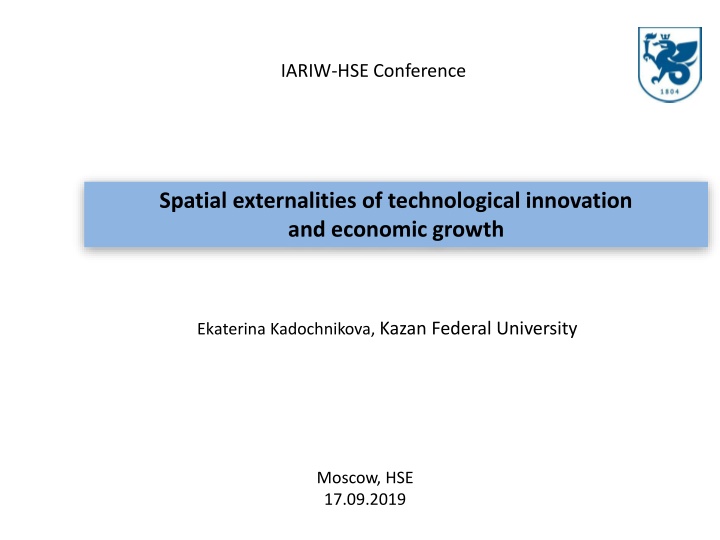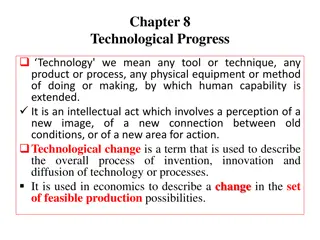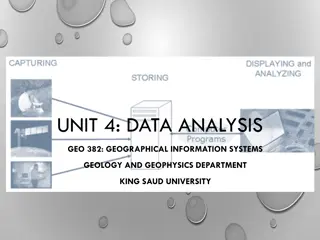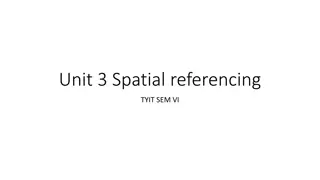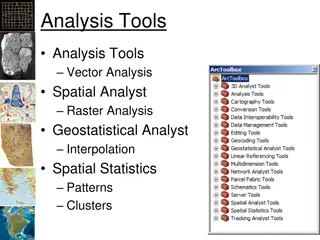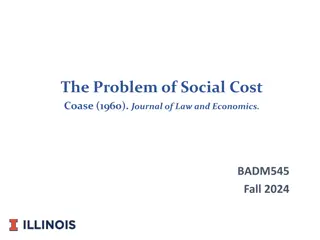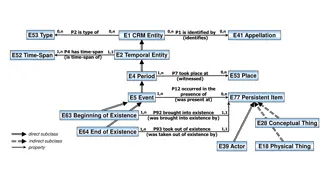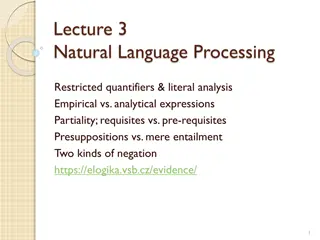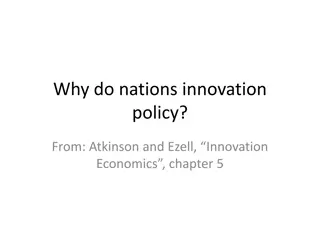Spatial Externalities of Technological Innovation and Economic Growth: Empirical Study
This study explores the spatial externalities of technological innovation and economic growth, focusing on the convergence of growth rates in different regions. It delves into the impact of knowledge capital, patents, human capital, and internet development on regional growth rates. Various theories and empirical findings are examined to understand the dynamics of innovation and economic development across regions.
Download Presentation

Please find below an Image/Link to download the presentation.
The content on the website is provided AS IS for your information and personal use only. It may not be sold, licensed, or shared on other websites without obtaining consent from the author.If you encounter any issues during the download, it is possible that the publisher has removed the file from their server.
You are allowed to download the files provided on this website for personal or commercial use, subject to the condition that they are used lawfully. All files are the property of their respective owners.
The content on the website is provided AS IS for your information and personal use only. It may not be sold, licensed, or shared on other websites without obtaining consent from the author.
E N D
Presentation Transcript
IARIW-HSE Conference Spatial externalities of technological innovation and economic growth Ek terina Kadochnikova, Kazan Federal University Moscow, HSE 17.09.2019
Table of Contents 1. Introduction 2. Literature 3. Methodology 4. Data & Variables 5. Estimation results 6. Conclusions
Motivation The main source of growth is technological progress [Barro, 2004], the cost of inventing a new product is reduced as the number of ideas grows [Romer, 2009] Technology transfer ensures sustainable macroeconomic growth with competitive imports from low-cost territories [Romer, 2010] Total factor productivity in the region (TFP) depends on both the equity of knowledge and the interregional redistribution of knowledge [Fischer et al., 2009] The growth of the service sector makes the modern digital economy less tangible and easier to measure through GDP, so it is difficult to assess the growth in the quality of goods, services and productivity in the economy, manifested in innovation [Coyle, 2014]
Objectives: Compare the rate of -convergence, short-term spatial externalities (effects) of annual growth rates of technological innovations and gross regional product for empirical testing of theoretical conclusions, reflected in [Coyle, 2014] Check whether we get the same conclusions about the growth of the economy, measuring the GRP and measuring innovation? Check whether the regions aspire to the same or to their own sustainable state Show the extent to which the level of economic development, the stock of human capital, the number of granted patents for inventions, the development of the Internet affect the convergence of growth rates in the regions
Literature Machlup F. (1962): Costs and number of employees in five groups of economic activities called The sphere of production and dissemination of knowledge" are measured Robbins (2006): Empirical findings on the uneven impact of knowledge across the US economy Kuo, Yang (2008): Positive impact of knowledge capital on economic growth in China, the assumption of "spillovers" of knowledge between provinces Fischer et al. (2009): Impact of interregional knowledge redistribution on overall factor productivity in the region Cuaresma, J. C. et al. (2014): assessment of the determinants of economic growth in terms of intercountry and intercountry convergence, taking into account spatial effects Kolomak (2010): Positive spatial externalities of economic growth rates prevail in the Western regions, negative ones in the Eastern regions Balash (2012): Impact of fixed capital investment in -convergence models, evidence of spatial externalities of growth Demidova, Ivanov (2016): Heterogeneity of regions in terms of conditions for interaction with other regions
Methodology (1) Data & Variables: 83 regions, Russia. From 2010 till 2016 Dependent variables: - the natural logarithm of GRP growth rate per capita - the natural logarithm of expenditure on technological innovation growth rate per capita ontrol variables: - the investments volume in fixed capital per capita, thousand rubles - the number of Universities students, thousand people - the number of patents granted for inventions, pcs. - the use of the Internet in organizations, %
Methodology (2) Spatial correlation and clustering of regions: - the global Moran's I (Anselin L., 1995) ( )( ) w X X X X ij i j N , i j = ( ) I X 2 w ( ) X X ij i , i j i where N number of regions, X the logarithm of expenditure on technological innovation growth rate per capita, the logarithm of GRP growth rate per capita, wij- weight boundary matrix elements. - the local Moran's I (Anselin L., 1995) ( ) w ( ) i i ij j = I N Li 2 ( ) i i
Methodology (3) Model specification: Linear regression model without spatial effects ( LS) Spatial lag model (SLM) Spatial Error model (SEM) Spatial Durbin model (SDM) Spatial Durbin Error model (SDEM) Model with spatial autoregressive lag and spatial interaction in errors (SAC) Models with spatial lags of independent variables (SLX) General nesting spatial model (GNS)
Methodology (4) - The model GNS i t k y y i t k y y + + , , = + + + + + + Wu + ln ln( ) ln ln( ) X y X W W y W , , , 1 i,t 2 , i t i t i t i t it , , i t i t - The model SAC = + i t k y y i t k y y + + , , + + + Wu + ln ln( ) ln y X W , , i t i t it it , , i t i t where yi,t GRP per capita or the cost of technological innovation per capita, in region i at time t; - parameter to be estimated; - convergence coefficient; W - boundary weighting matrix; - spatial autoregressive coefficient for the dependent variable; 1, 2 vectors of spatial coefficients for independent variables; - spatial autocorrelation coefficient for shock, it random errors.
Methodology (5) Marginal effects = ( ) ( ) ( ) , M X M X M X r indirect r total r direct 1 N = ( ) ' ( ) , N M X i S W i r total N r 1 N = ( ) ( ( )), M X tr S W r direct r = 1 (W) (I W) , S n r r = y/ X r r where M(Xr)total - total marginal effect, M(Xr)direct direct marginal effect, M(Xr)indirect indirect marginal effect, N number of observations, Sr(W) higher order weighing matrix, In n-dimensional identity matrix, spatial autoregression coefficient, - regression coefficient for Xr, r- independent variable number, tr(Sr(W)) - matrix trace Sr(W)
Methodology (6) The basic hypothesis rate of Check the H1: technological innovation growth rates in the modern economy is higher than the rate of -convergence of economic growth rates H2: short-term spatial technological innovation growth rates and spatial externalities of economic growth have different effects on -convergence processes the -convergence of Comparison convergence and speed of convergence in the models for the different dependent variables - Comparison of spatial externalities "other region - given region" on the basis of spatial autoregressive coefficients. of coefficients of externalities of - Comparison of spatial externalities given region other region" on the basis of indirect marginal effects The conclusion on statistically significant difference is proposed to be formulated on the basis of model values confidence interval boundaries comparison: if the intervals intersect, there are no differences between the coefficients
The nominal growth rate of gross regional product per capita (2016/2010) The nominal growth rate of cost on technological innovation per capita (2016/2010)
The real growth rate of gross regional product per capita (2016/2010) The real growth rate of expenditure on technological innovation per capita (2016/2010)
Spatial Correlation Indices from 2011 to 2016 Table The global Moran's I Indicator 2011 2012 2013 2014 2015 2016 GRP per capita growth rate 0,027 -0,008 0,159** 0,225*** 0,132** 0,098* Expenditure on technological innovation per capita growth rate 0,069 0,136** 0,129** 0,152** 0,234*** 0,220*** Table The speed and time of -convergence of economic growth rates Models and specifications 2013 2014 2015 2016 SAC speed of -convergence , in fractions of pc 0,13737 0,135581 0,094001 0,090387 SAC time of -convergence , in years 5,04585 5,11242 7,37385 7,66863 GNS speed of -convergence , in fractions of pc 0,407925 0,328431 0,238784 0,215331 GNS time of -convergence , in years 1,69920 2,11048 2,90281 3,21899
Spatial correlation of GRP growth rates per capita from 2011 to 2016
Spatial correlation expenditure on technological innovation growth rate per capita from 2011 to 2016
Estimation results Table Estimates of spatial models of unconditional -convergence Models and variables Years 2013 2014 2015 2016 Y = the natural logarithm of GRP growth rate per capita SAC: -0.03** -0.04* -0.02 -0.03 Convergence coefficient 0.64*** 0.61*** 0.58** -0.58* Spatial lag dependentvariable -0.78*** -0.57* -0.53 0.61*** Shock spatial lag 0.32** 0.38** 0.35* 1.13*** Intercept 0.13 0.10 0.22 0.22 Test: p-value LR GNS: -0.15 -0.11 -0.19 Convergence coefficient -0.15* 0.61*** 0.64*** 0.58** -0.59** Spatial lag dependentvariable -0,12 -0,104 -0,016 0,28 Spatial lag of GRP per capita in 2010 -0.78*** -0.56* -0.53 0.64*** Shock spatial lag 0.01 0.004 0.003 0.03 Intercept 0.23 0.18 0.39 0.27 Test: p-value LR
Table Estimates of spatial models of conditional -convergence Models and variables Years 2013 2014 2015 2016 Y = the natural logarithm of GRP growth rate per capita SAC: Convergence coefficient Investments Number of students Internet development Number of patents granted Spatial lag dependentvariable Shock spatial lag Intercept Test: p-value LR GNS: Convergence coefficient Investments Number of students Internet development Number of patents granted Spatial lag dependentvariable Spatial lag of GRP per capita in 2010 Spatial lag of investment in 2010 Spatial lag of students in 2010 Spatial lag of Internetdevelopment in 2010 Spatial lag of the number of patents granted in 2010 Shock spatial lag Intercept Test: p-value LR -0.17*** 0.00*** 0.00* 0.00 0.00 0.11 -0.01 1.05*** 0.74 -0.18** 0.00*** 0.00 0.00 0.00 -0.08 0.36 1.30*** 0.17 -0.12** 0.00** 0.00** -0.00 -0.00 -0.53* 0.69*** 1.40*** 0.01 -0.12*** 0.00*** 0.00** 0.00 0.00 -0.55* 0.72*** 1.44*** 0.00 -0.80*** 0.74*** 0.28* -0.07 -0.09 -0.49 -0.39 -0.15 -0.18 -0.37* 0.65 0.52* 0.07 0.36 -0.46* 0.65*** 0.27* -0.17 -0.23 -0.47 0.14 -0.76 -0.37 -0.34 0.38 0.66*** 0.04 0.03 -0.44* 0.63** 0.20 -0.08 -0.27* -0.42 0.40 -0.89 0.59* -0.25 0.49 0.66*** 0.03 0.01 -0.68** 0.68*** 0.14 -0.12 -0.02 -0.47 -0.18 -0.41 -0.24 -0.52** 0.39 0.62*** 0.06 0.03
Table - The speed and time of -convergence of economic growth rates Models and specifications 2013 2014 2015 2016 SAC speed of -convergence , in fractions of pc 0,13737 0,135581 0,094001 0,090387 SAC time of -convergence , in years 5,04585 5,11242 7,37385 7,66863 GNS speed of -convergence , in fractions of pc 0,407925 0,328431 0,238784 0,215331 GNS time of -convergence , in years 1,69920 2,11048 2,90281 3,21899
Table Estimates of spatial models of unconditional -convergence Models and variables Years 2015 2013 2014 2016 Y = the natural logarithm of expenditure on technological innovation growth rate per capita SAC: Convergence coefficient 0.82*** 0.81*** 0.86*** 0.68*** 0.18 0.04 0.40** 0.58*** Spatial lag dependentvariable -0.28 0.00 -0.31 Shock spatial lag -0.63*** 1.42*** 1.67*** 0.87*** 0.63*** Intercept 0.32 0.91 0.02 0.00 Test: p-value LR GNS: Convergence coefficient 0.76*** 0.76*** 0.64*** 0.54*** 0.02 0.25 0.43** 0.68*** Spatial lag dependentvariable 0,14 -0,15 -0,03 -0,13 Spatial lag of expenditure on technological innovation per capita in 2010 -0.28 -0.22 -0.35 -0.73*** Shock spatial lag -0.01 -0.002 -0.02 -0.02 Intercept 0.47 0.97 0.05 0.00 Test: p-value LR
Table - Estimates of spatial models of conditional -convergence Models and variables Years 2015 2013 2014 2016 Y = the natural logarithm of expenditure on technological innovation growth rate per capita SAC: Convergence rate Investments Number of students Internet development Number of patents granted Spatial lag dependent variable Shock spatial lag Intercept Test: p-value LR GNS: Convergence rate Spatial lag dependent variable Intercept - 0.81*** 0.00 0.00 0.00 0.00 0.17 -0.34 1.60 0.27 0.78*** -0.07 -0.06 -0.00 0.19 -0,05 0.12 0.27 0.25 -0.02 -0.01 -0.15 0,02 0.41 0.77*** 0.00 0.00 -0.01 0.00 0.10 -0.23 1.92 0.67 0.72*** 0.03 0.09 -0.05 0.05 0.24 -0.19 0.16 0.18 -0.05 0.76 -0.59 0.07 0.27 0.78*** 0.54*** 0.00 0.00 0.00 0.00 0.43*** 0.62*** -0.50* 0.19 0.02 0.64*** 0.44*** 0.04 0.01 -0.04 0.09 0.33 -0.09 0.11 0.28 0.19 0.34 -0.42 0.03 0.02 2.4e-06** 2.0e-03* 0.00 0.00 -0.93*** -0.62 0.00 0.23* 0.12 -0.01 -0.01 0.65*** -0.11 -0.13 0.07 0.06 0.48 -1.01*** 0.03 0.00
Table - The confidence intervals of the spatial autoregression coefficient in 2015 and 2016 Models GRP per capita growth rate The growth rate of cost on technological technological innovation per capita Unconditional -convergence models [0,1915**; 0,9680**] [-1,1312*; -0,0360*] [0,1777**; 0,9783**] [-1,1191**; -0,0744**] [0,1598**; 0,6322**] [0,4007***; 0,7583***] [0,1683**; 1,0387**] [0,4284***; 0,9253***] SAC, 2015 SAC, 2016 GNS, 2015 GNS, 2016 Conditional -convergence models [-1,0009*; -0,0617*] [-1,004*; -0,0987*] [0,2097***; 0,6491***] [0,4698***; 0,7677***] [0,2884**; 0,9479**] [0,4345***; 0,8746***] SAC, 2015 SAC, 2016 GNS, 2015 [-1,0176; 0,0726] GNS, 2016 [-0,9904;0,1438]
TableConfidence intervals of indirect marginal effects in -convergence models in 2015 and 2016 Models Variables and GRP per capita growth rate The growth rate of expenditure on technological technological innovation per capita Unconditional - convergence Conditional - convergence Unconditional - convergence Conditional - convergence IL IU IL IU IL IU IL IU SAC, 2015 -0.16 0.01 7,7e-03** 9,8e-02** grp_ln 0.20* 1.10** 0,24*** 1,14*** innov_ln invest stud inter pat -6,6e-07** -1,9e-04* 0,00 0,00 -5,7e-08** -9,1e-06* 0,00 0,00 0,00 0,00 -0,02 0,00 0,00 0,00 0,03 0,00 SAC, 2016 grp_ln -0.01 0.06 0,01** 9,24** 0.54*** 1.59*** 0,51** 1,30** innov_ln invest stud inter pat -7,0e-07** -2,0e-04** 0,00 0,00 -9,8e-08** -2,0e-05** 0,00 0,00 1,2e-06** 8,4e-04* -0,03 0,00 8,1e-06** 7,2e-03* 0,04 0,00
TableConfidence intervals of indirect marginal effects in -convergence models in 2015 and 2016 Models Variables and GRP per capita growth rate The growth rate of expenditure on technological technological innovation per capita Unconditional - convergence Conditional - convergence Unconditional - convergence Conditional - convergence IL IU IL IU IL IU IL IU GNS, 2015 grp_ln -1.13 0.68 -0,41 1,06 innov_ln 0.03 1.25 -0,28 0,67 invest -1,76** -0,14** -0,43 1,03 stud -0,85** -0,01** 0,03 1,65 inter -0,57 0,07 -0,07 1,04 pat -0,63 1,43 -0,55 2,87 GNS, 2016 -0.19 0.83 -0,19 1,32 grp_ln innov_ln 0.26 1.54 0,10** 1,01** invest -1,92** -0,20** -0,67 0,69 stud -1,03** -0,16** -0,07 1,15 inter -0,54 0,16 -0,26 0,80 pat -0,55 1,55 -0,10 3,17
Conclusions (1) Positive spatial autocorrelation of the regions is increasing and spatial effects need to be taken into account in econometric studies of the growth rates of the modern digital economy in the Russian regions. The speed of -convergence of economic growth in the regions is slowing down, there is a process of -divergence of costs growth rates for technological innovations in the regions In the direction of "other region given region" there are no statistical differences between the effect of positive spatial externalities of the technological innovation growth (cooperation of regions) on the -divergence of its rates and economic growth negative spatial externalities (competition of regions) on its -convergence rates. In the direction "given region other region" statistically different predominance of spatial externalities of technological innovations costs over economic growth externalities was found Thus, the conclusion [Coyle, 2014] about the impossibility of unambiguously assessing productivity growth in the modern economy, manifested in innovation, based on the measurement of GDP, is confirmed.
Conclusions (2) The positive relationship of the variable "volume of investments in fixed capital per capita, rubles" with the rate of economic growth in most models of conditional - convergence from 2013 to 2016 were confirmed, as well as the rate of growth of technological innovation costs in the GNS models of conditional -convergence for 2015, 2016, which is consistent with [Balash, 2012] Variable "Internet usage in organizations, %" connection is not confirmed and, unlike [Fischer et al., 2009; Scherngell et al., 2014], variable "number of granted patents for inventions, pcs." with the rate of economic growth and the rate of growth in the cost of technological innovation The ambiguity of the results in the regressions of unconditional and conditional - convergence of growth rates in the regions is shown, which is consistent with [Glushchenko, 2010; Kolomak, 2014] Finally, the ambiguity results of short-term spatial externalities from cross- sectional data for Russian regions due to small samples, previously obtained in [Demidova, 2014], speaks in favor of identifying long-term spatial externalities on panel data analysis models
